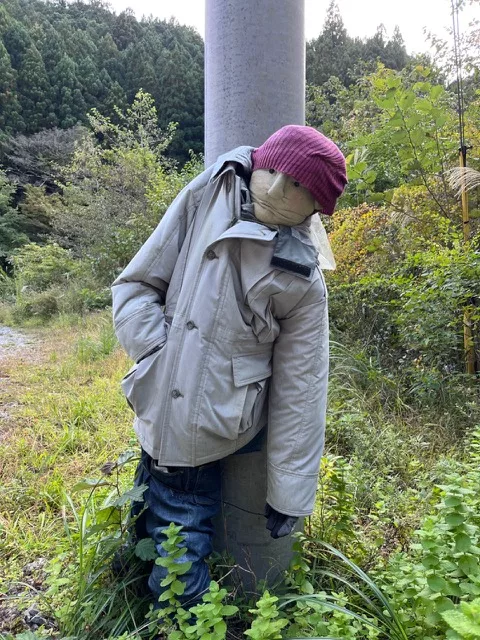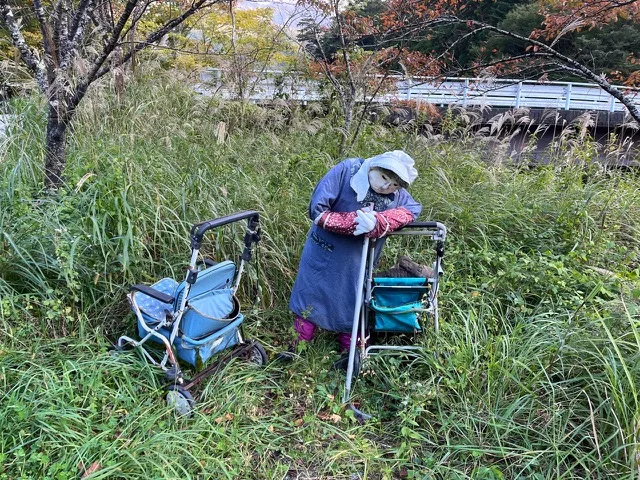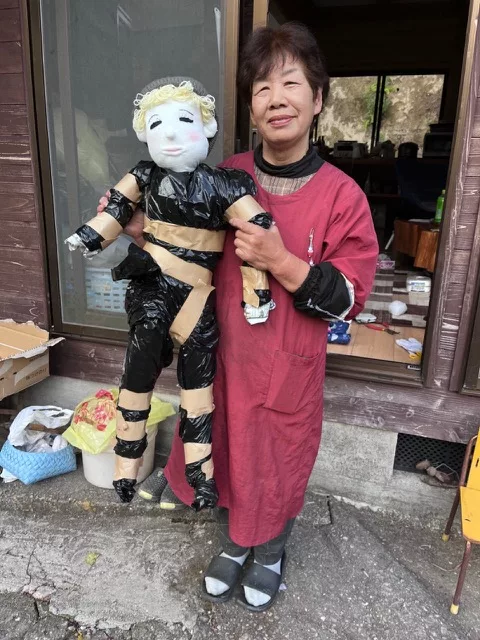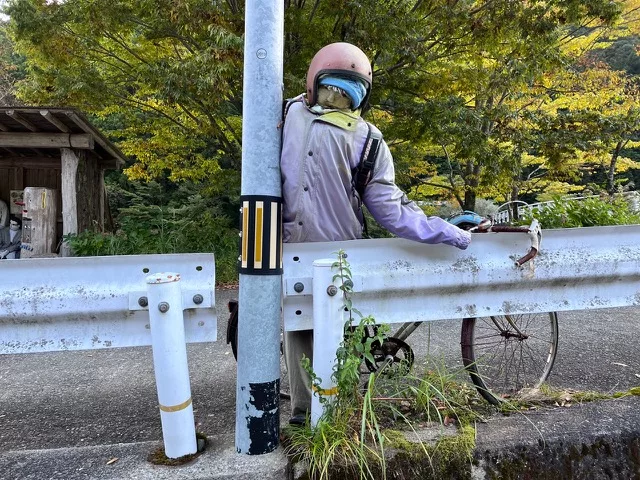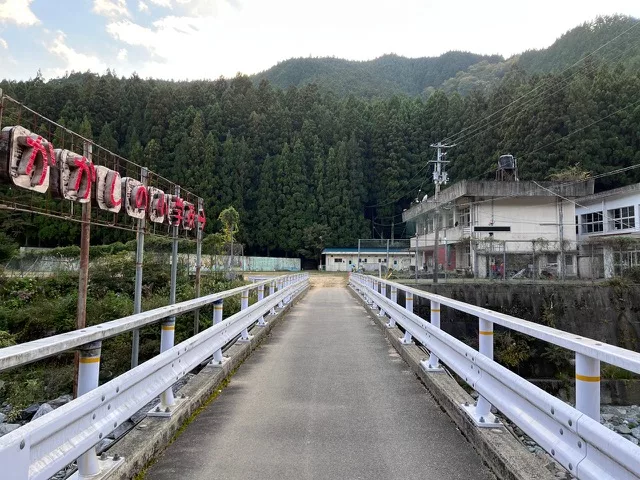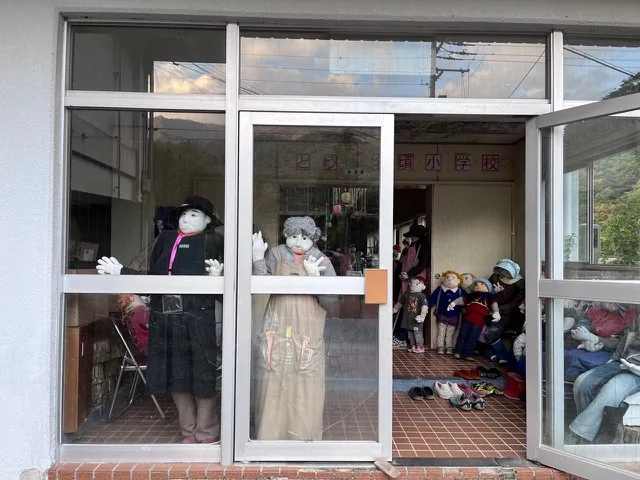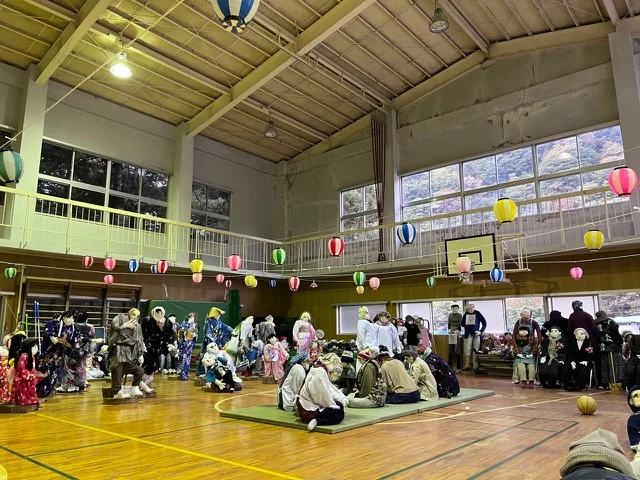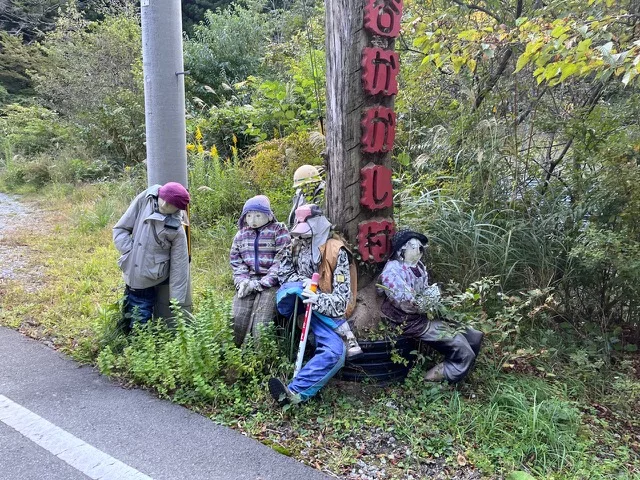The drive to Nagoro is wilder than we had imagined. It was supposed to be a quick stop on route to the Shimanto River, the last natural river in Japan. Apparently a woman living in this mountain village has created several hundred scarecrows to fill in the empty spaces left behind by the villagers that have passed away. We thought it might be interesting for exploring the loneliness aspect on this research trip. Finding answers to the question of what happens in rural villages when the population fades away. What strategies are applied by the people remaining.
Tripadvisor says: “Don’t come here by train, if you don’t really want to come here. It is very hard to reach.” We have a car and it is a detour of a mere 30 kilometres.
From Tokushima City the highway leads west along the flatlands, the rice paddies and – unusual for Japan – huge parking lots: in front of Pachinko parlours, roadside coffeeshops, the hotels.

The road away from the highway first follows the Yoshino River, then steers off south into the mountains along a small stream of water. The road is narrow. To peep around corners mirrors have been set up at each curve. The frequency of mirrors along this stretch is unusually high. Every 50 metres a disc illuminates the invisible counter-traffic. I laugh about this precaution, but just then a huge truck comes steaming down the mountain towards us and I notice its reflection last minute, slow down just in time, nearly missing the truck. Mirrors in Japan have always held sacred qualities and I think of the Makyo, magic mirrors, that reflect hidden images. Where does this road take us to?
After a while the mirrors become less but the amount of trucks stays the same. They are logging trucks coming down from the mountains, heavily packed with hinoki, cypress stems.
The road climbs higher yet. Another car trails us and after a while I decide to let the car pass: it seems like a great idea because if a truck comes towards us, this car has to confront it first. It is an older couple and they look surprised when they overtake us and stop after about a kilometre, to let us pass again.
The landscape changes. It feels ancient and I feel as if we are driving into a fairy tale. The few settlements become even less, and there is a sense of remoteness to this environment that feels like a liminal space between the world we are familiar with and another world, hidden. The high ferns, streams trickling down from rocky surfaces, moss. Stones falling down from cliffs above the road. Potholes. Drops at the side of the road, leading steeply down into the undergrowth of a valley.
Eventually we come to mountain village with roads so narrow that I am afraid of scraping the windows of the houses. A sign in front of a gas station reads: last gas station before the mountains. Even though our gas tank is filled three quarters I stop to fill it completely. Four people look up from a game they are playing inside the gas station hut. An older lady, a truck driver in an iconic driving suit and a fine moustache, an older man and the young man who jumps up and comes out to fill our car. When I say hello they laugh amongst each other and say: “She has said hello.”
It takes us 45 minutes for 19 kilometres. At the top of the pass the mountains are below us. Clouds are rising from amidst the trees.
Eventually the road winds down again and descends into the Iya valley. Somewhere here must be Nagoro village, the maps tells us. Everything feels far away suddenly and we are not sure if anything is left of the village we heard about. But then we spot five dolls at a rusty village sign. They are human sized and made of cloth. Each has a different stitched face with a unique expression. They wear real clothing, trousers, skirts, shoes, hats. It is a silent welcome, but a welcome nevertheless.
We drive on and pass some falling houses. Whoever lived here once has left a long time ago. Some overgrown fields and no more dolls for a while. Then a field of bright pink cosmos flowers and amidst them another doll. Suddenly there are dolls wherever one looks. One at the side of the road, holding his bike. An old lady is hunched over a pram with a baby – both dolls. Someone stands on the bridge not moving. It is another doll.
The crows hover above us, the forest closes in.
Then we see a woman in a red jacket walking to a field at the edge of the forest. She spots us and comes towards us, winking. She must be in her late 60s. “Welcome”, she says, when she is close. She invites us to follow her. “The maker of the dolls is here. She lives over there. I am on my way there, just follow me.”
More dolls on the way inhabiting abandoned houses. In front of an old farmhouse more dolls and a bag of clothes that someone has been sorting through. “Aya, visitors”, the lady in the red anorak shouts. The door opens and the smiling face of an elder lady greets us. This is Ayano Tsukimi. I have read that she made these dolls to face the loneliness of this life in the mountains. Shikoku is the least populated of the Japanese main islands. Young people move away while the older ones are left to cope.
“I am not doing it out of loneliness. No, I am not lonely. I started doing this because with so little people around the crows and deer eat all my crop. The scarecrows help. And then I never stopped doing it.” After a while she insists: “I am not lonely.” Ayano tells how she had decided to move back into the mountains in her 20s, after having spent some time in the city, missing the quietness of the rural life. “Come with me, there is more.” Together we embark on a strange walk through the village. Once 300 people lived here, now only 25 people are alive. The youngest is her sister who had welcomed us. At the end of town is a school building. Dolls look out of the windows. The swings outside move slightly in the wind. Mrs. Ayano has made more than 700 dolls now. She has been on TV for it and people from all over Japan send old clothes to her. The remaining villagers enjoy her dolls, while some people who come from the city find it eerie.
She opens the doors to the school with a key. Inside is a huge gymnasium, filled with hundreds of dolls celebrating a matsuri, a folk festival. Some are engaged in rope pulling, some sit around a table and snack, some just hang out around the fringes and watch the others. Children, adults, teachers and oni (demon) people with horns on their heads. “We held this matsuri every years and people from other villages came each year, but then with corona we had to stop. Now we cannot meet one another. Everyone is old, so we have to be be careful. We hope that in a few more months things can return to normal.” Ayano tells us to stay where we are and walks to a corner. She puts on music for the Awa Odori, the traditional dance of the region that they dance when they unite. The loudspeakers blast out the tune and Ayano`s sister urges us to dance with her. The three of us form a circle and move rhythmically. The dolls watch. It is an easy dance, steps forward, the hands above the heads. We dance round and round like this and both ladies clap their hands and shout Jozou! Well done! They laugh and enjoy and so do we.
When the evening sets, we get up to go. The drive out of the valley will be long and there are no street lamps. “Be careful.” they say good-bye in the way one does here in Japan. Be careful.
We are careful. The best thing about driving at night is that there are no trucks. But we have a difficult destination to reach. About an hour from here, in another mountain village called Aruse, is an abandoned school. After the last students left, the village people have converted it into a hostel so as to attract visitors. I have booked us a room there. Loneliness – there was none of that in Nagoro. While we drive to Aruse, the darkness of the mountains drapes the valley in a thick cloth woven by the night. Nothing is easy here. But the mountains have an ancient ring to them, and there is a calmness that is hard to find elsewhere.

